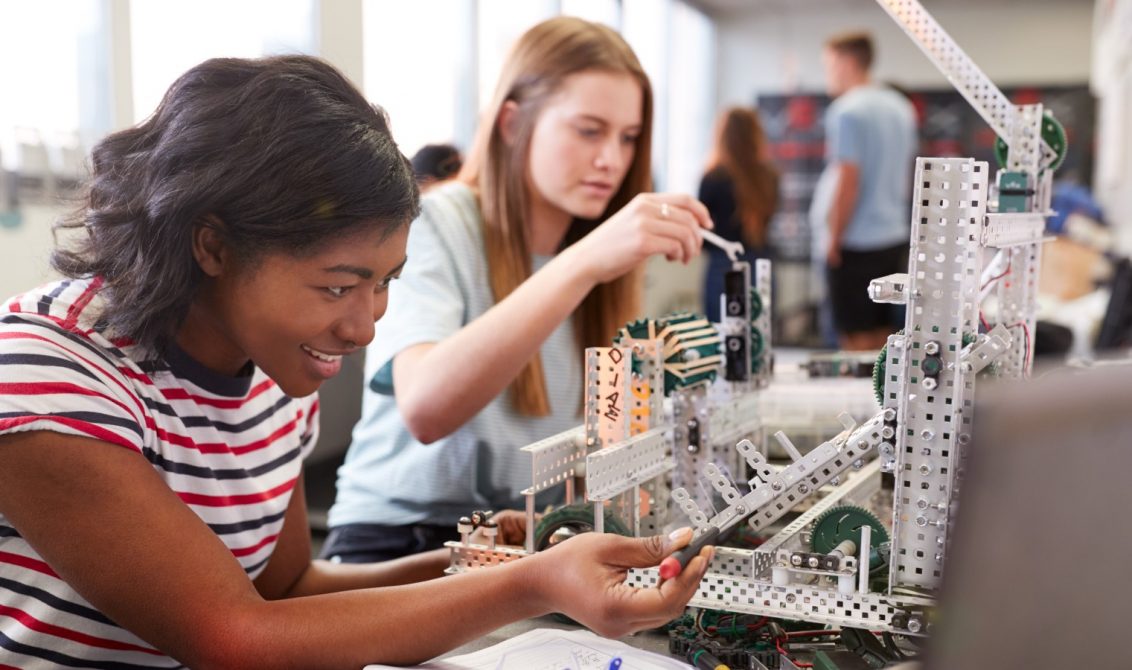
Tackling unconscious bias and building resilience in girls, to help them succeed in Science, Technology, Engineering and Maths (STEM) careers.
I met James Watson once. He gave a guest lecture during my first term studying natural sciences at university. Fifty years previous, he and Francis Crick had walked into The Eagle pub in Cambridge, a stone’s throw from the lecture theatre in which I was sitting, and declared, ‘We have found the secret of life’. Several years later, they shared the Nobel prize in physiology or medicine for their discovery.
As a young, aspiring biologist, I was starstruck. I had devoured the story (both the book and the film starring Jeff Goldblum), a daring tale of two scientists who, with the help of a stroke of genius, deduced the structure of DNA. I was keen to hear his story about the discovery, and to get his autograph (this was long before the advent of the selfie). What followed was somewhat odd: Watson dwelled, as he did in his book, on the ‘difficult’ Rosalind Franklin, the scientist working at Kings who produced the X-ray crystallography which Watson and Crick used to help them make their discovery. He quite openly mused on the role of women in science, a world he clearly thought should be for men alone.
Is it to do with mindset?
Recently, I was having coffee with a good friend from university. She’s a financial director, and I work for Pearson. We’re both in what I would loosely term as academic careers; hers is very numerate, and I have been fortunate enough to be able to use my science background in leading on the redevelopment of our science GCSEs and A levels. But neither of us are in science careers directly. Knowing I was writing this article, I broached the subject. Discussing it, we both realised that we’d had that broad sense of not being good enough to turn it into a career. This hadn’t been shaped by our university experience, but was always something we’d felt about ourselves.
What are the statistics?
My friend pointed out that, as undergraduates doing a biology degree, it had been around 70/30 in favour of women (of course over in the physical sciences, the opposite was true and there is much to be done to encourage girls into physical sciences), at PhD level this trend reversed in favour of men, and of the 20+ lecturers, we only remembered two women. This anecdote is backed up by UNESCO stats: fewer than 30% of researchers are women. (And to boot, numerous studies have found that women in STEM fields publish less, are paid less for their research and do not progress as far as men in their careers.)
As educators at school level, we often think of it in terms of getting more girls into university. We, quite sensibly reason that, if we do that, we have played our part. And we are right: there is a gender imbalance, and getting more girls into STEM degrees is critical. But do we need to do more to help build resilience, and not just get girls into university, but equip them with the resilience to take their involvement in science through university and into a career? According to the latest U.S. census, only 1 in 7 women with a degree in STEM actually works in the field. I guess I’m just one of the 6 in 7.
How do we help more girls to pursue these types of jobs?
The American Association of University Women produced a report on women in stem careers, entitled called ‘Why so few?’. In this, they make a series of recommendations, several of which are pertinent at school level. The recommendations are simple, but useful. As girls’ achievements and interest in maths and science are shaped by the environment around them, parents and educators must commit to:
- Counteracting unconscious bias. Educators can look at the effect their biases can have on their teaching, and can work to create an environment that counters gender-science stereotypes. Parents can resolve to be more aware of messages they send their daughters and sons.
- Spreading the word about women’s achievements in maths and science and exposing girls to successful female role models.
- Teaching students about the ‘stereotype threat’, a phenomenon that has been proven to exist: the very existence of a negative stereotype (e.g. boys are better than girls at mathematics) adversely affects the test performance of members of the negatively stereotyped group. Teaching students about this has been shown to mitigate its effect.
- Showing girls that intellectual skills, including maths and science skills, grow over time. Interventions designed to promote a growth mindset (viewing intelligence as a changeable, malleable attribute that can be developed) among students as opposed to a fixed mindset (viewing intelligence as an inborn, uncontrollable trait) benefits girls in maths and science, because girls with a growth mindset are less affected by stereotype threat.
- Encouraging and helping girls to develop their spatial skills. Boys persistently outperform girls when tested on spatial skills, and these skills are useful in STEM fields, especially engineering. Spatial skills are not fixed and can be developed over time, and girls can be encouraged to develop them through construction toys and 3D computer games.
- Helping girls recognise their career-relevant skills. Studies show girls are less likely than boys to interpret academic successes in maths and science as an indication they have the skills necessary to go into STEM fields. Helping them recognise that their success in school is an indication they have the skills to succeed in STEM professions.
- Reducing reliance on stereotypes by making performance standards and expectations clear. This is at the heart of good teaching, but interestingly, research shows that the same letter or number grade on a maths test signals something different to girls than it does to boys. Educators can help students better understand their grades by giving detailed feedback and recommendations to improve. The more educators reduce students’ uncertainty about performance, the less likely students will use stereotypes to assess their abilities.
Does more need to be done in terms of bias and stereotypes?
As a society, we may have moved beyond accepting the odious and overt sexism displayed by James Watson, and it’s easy to proclaim him a dinosaur from a bygone age, but it’s clear there’s still work to be done. We need to all be aware of our unconscious bias, take steps to mitigate this and be aware of how we frame ideas to children (boys and girls).
And so back to the discovery of DNA. Rosalind Franklin’s academic prowess was dismissed by Watson and Crick, who were nonetheless happy to use her X-ray crystallography work to help crack their code. Commentators who have studied her notebooks marvel that, working alone as a pariah in a man’s world, she got mighty close to working out the structure on her own. It is a great travesty that she died before Nobel prizes were awarded. So, nowadays, it’s Rosalind Franklin who is my hero – or heroine – in this story.
Interested in your own unconscious bias? Check it here for free.
About the author

